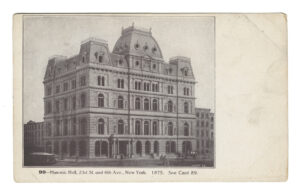
Artifact of the month!


Chancellor Robert R Livingston Masonic Library of Grand Lodge Presents – Artifact of the Month!
Thank you Grand Master Steven Adam Rubin for initiating this program and Br JW Short for the video production.
Please enjoy your history!
Among the many gems in the Chancellor Robert R Livingston Library’s collection is the first Masonic book printed in America. The book is called The Constitutions of the Free-Masons and was printed in 1734 by Benjamin Franklin.

In our photograph collection, I stumbled upon the photograph of a gentleman name Edward Giddings among the portraits of high-profile Masons from the mid-late 19th century. I was not aware of who Edward Giddings really was until the research revealed that he was one of the important players of the Morgan Affair and anti-Masonic movement.
To summarize the Morgan Affair in 1826, it was the murder mystery that ultimately led to the anti-Masonic frenzy which almost destroyed Freemasonry in North America. It all began when William Morgan, or Captain Morgan, announced his publishing of Illustrations of Masonry, claiming to expose the secrets of Freemasons to the public. Morgan later vanished and was never found again. He was last seen in Canandaigua being taken into the carriage right after being released from debtor jail.
When Morgan didn’t come home, and Mrs. Morgan began searching for her disappeared husband, the rumors, the conspiracy, and the sensation began to spread throughout New York. While there has been no solid account of what really happened, the most popular consensus is, Morgan was allegedly abducted and murdered by the members of Masonic Fraternity. The scandal had spread far and wide, leading the country into the hysteria of the Anti-Masonic movement.
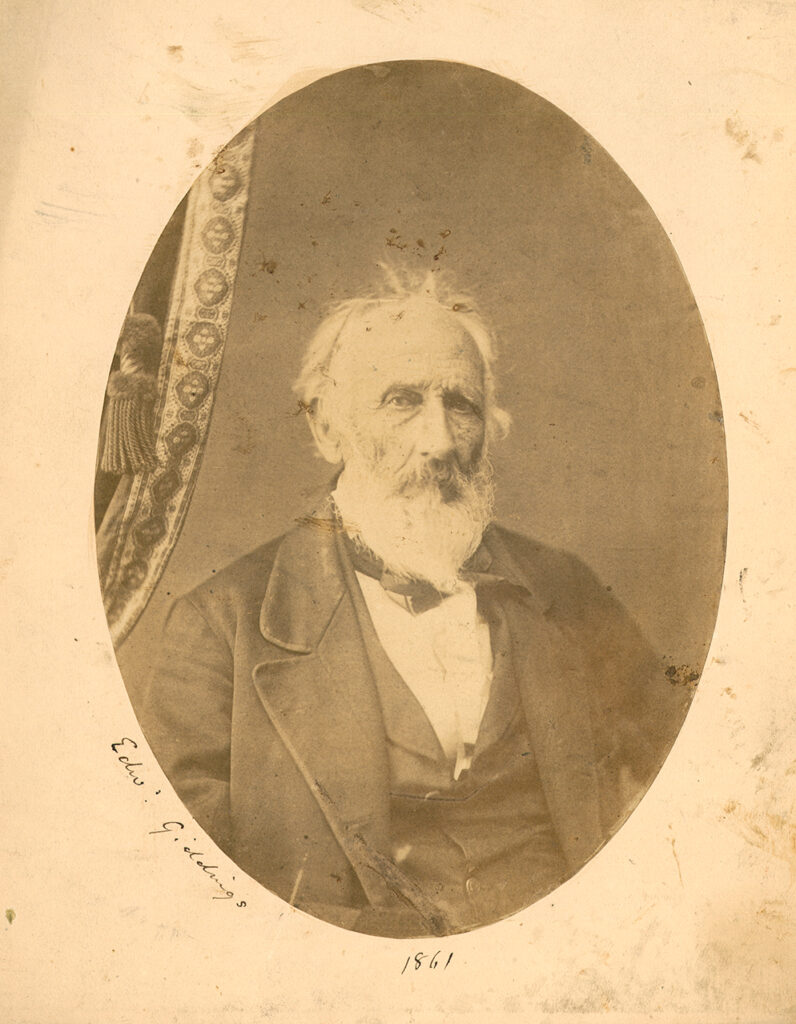
Edward Giddings, at the time, was a Mason, and the lighthouse keeper at Fort Niagara, and he was one of the prime witnesses of Morgan’s final moment, as the popular theory being Morgan was murdered by drowning in Niagara River. Ironically, his testimony was not believed and was rejected by the court based solely on his atheism.
Despite this, Giddings later wrote his own testimony, describing his involvement in the scene in the Anti-Masonic Almanac in 1829, titled An account of the savage treatment of Captain William Morgan, in Fort Niagara: who was subsequently murdered by the Masons, and sunk in Lake Ontario, for publishing the secrets of Masonry. Although it cannot be proven true, the Anti-Masonic movement was more than eager to weaponize his testimony against the Masons.
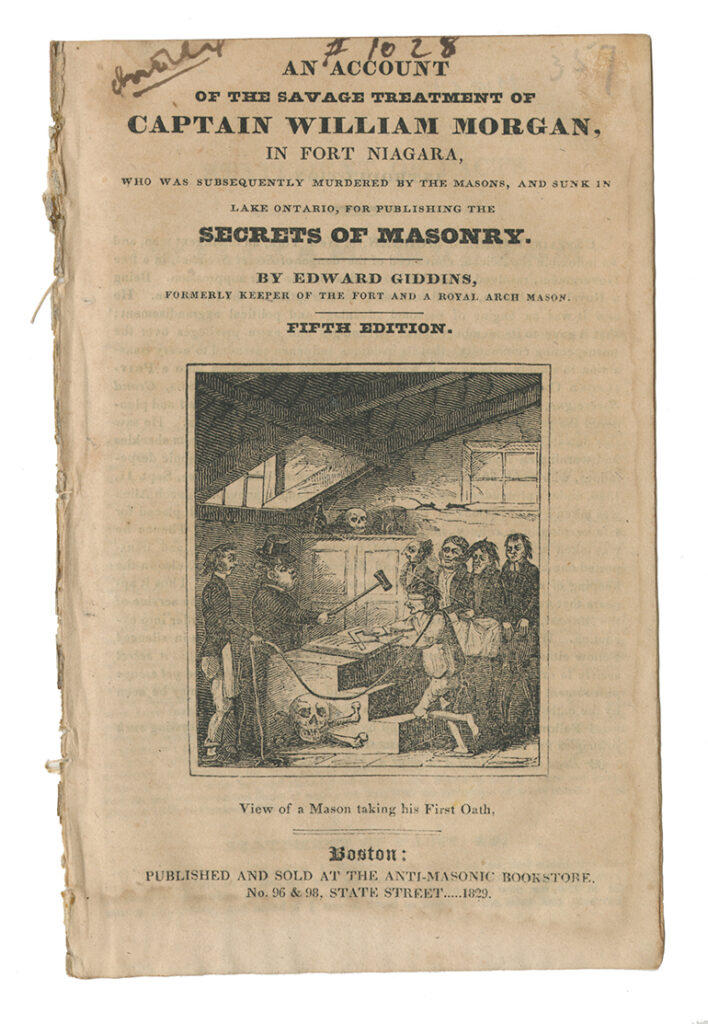
Later, the other photograph in the collection also caught my attention. It is a portrait of Giddings next to Rob Morris, the distinguished Masonic author at the time. The story behind Rob Morris being in the same picture with Edward Giddings is the curiosity worth looking into. How and when did they meet?
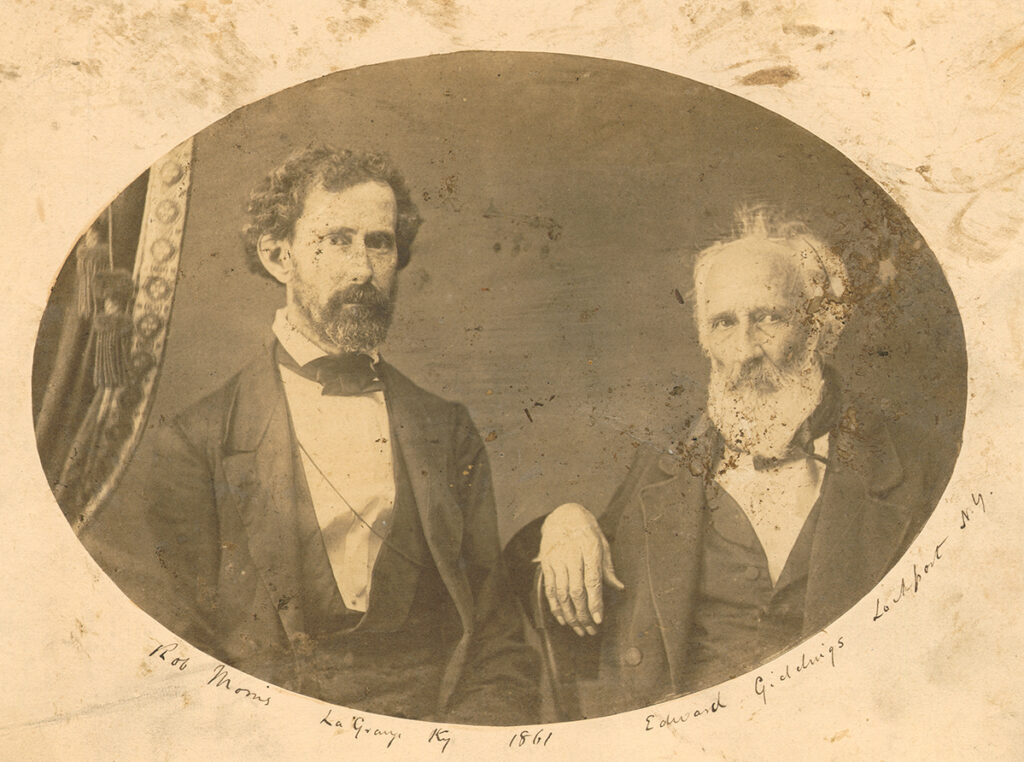
Rob Morris was the celebrated Masonic author and poet, the Past Grand Master of Kentucky, and the founder of the Order of the Eastern Star. He was known for his several Masonic publications, such as Freemasonry in the Holy Land, The lights and shadows of Freemasonry, The level and the square, and one of them is William Morgan or political anti-masonry.
I looked into William Morgan or political anti-masonry, as my hunch is Morris might include the backstory of these photographs in his Morgan Affair publication, and I am correct. In the book William Morgan or political anti-masonry, published in 1883 by Macoy Publishing, Morris wrote the account of his personal investigation on Morgan’s disappearance. His search for the truth eventually led him to meet Edward Giddings in person at Lockport, New York in 1861. There is no doubt that the two photographs of interest were taken during their brief encounter.
In his book, Morris, understandably, held some resentment toward Giddings as he questioned his atheism belief and described Giddings as a deceiver who made up his testimony for fame and money, not to mention how much his ‘testimony’ had hurt the Freemasonry and many of its members. As they discussed, Giddings confessed to Morris that, the truth was, he did not see nor know what actually happened to William Morgan in his final moment.
According to Morris, Giddings was raised in a lodge in Boston around 1810 despite being an atheist. Giddings admitted to him that he lied about his religious faith upon initiation into Freemasonry, and he had so little commitment to the craft as a result. Giddings died in 1862, a year after they met, at Fort Niagara, New York, at the age of 77.
Rob Morris was one of the biggest contributors of the Grand Lodge of New York’s collection. His several Masonic portraits and publications are the valuable resources for research and education of American Masonic History. This little discovery in the Grand Lodge collection really pique my interest, and I am pleased to share its story in this blog post.
Reference
Morris, Robert. William Morgan, or, Political Anti-Masonry: Its Rise, Growth and Decadence. R. Macoy, 1883.
Thank you for your interest in our special presentation in occasion of the 77th Annual Metropolitan Region’s Masons & Families Dedication Service & Breakfast.
For the first time, we are holding both in-person and online artifact presentation. These are the amazing artifacts from the Grand Lodge of New York that can be seen at the event and also in the library website and online museum:
The Washington Square Arch Trowel
An ivory and sterling trowel used to lay the cornerstone of the Memorial Arch at Washington Square Park, on the date of May 30th, 1890, by the Grand Master MW John W. Vrooman.
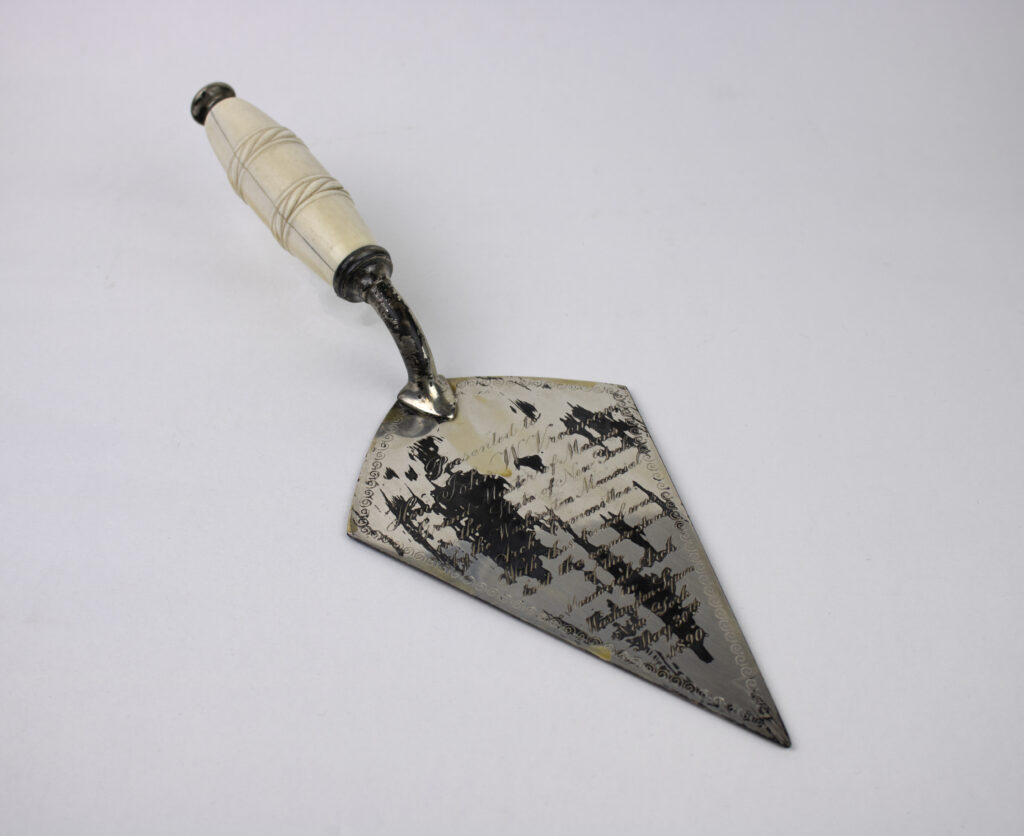
A Master Mason apron, made of white silk, decorated with light blue trim and embroidered Masonic symbols.
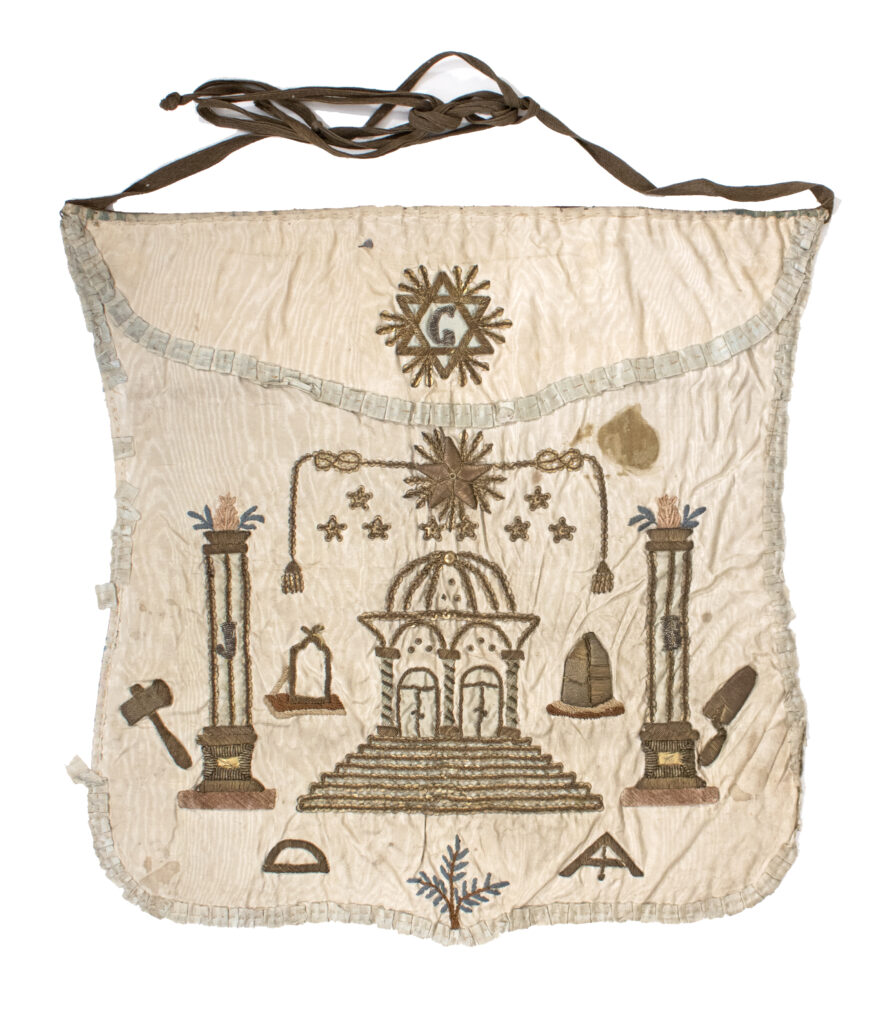
Junior Warden’s Jewel donated by Morris Lookatzer, member of Justice Lodge No. 753.
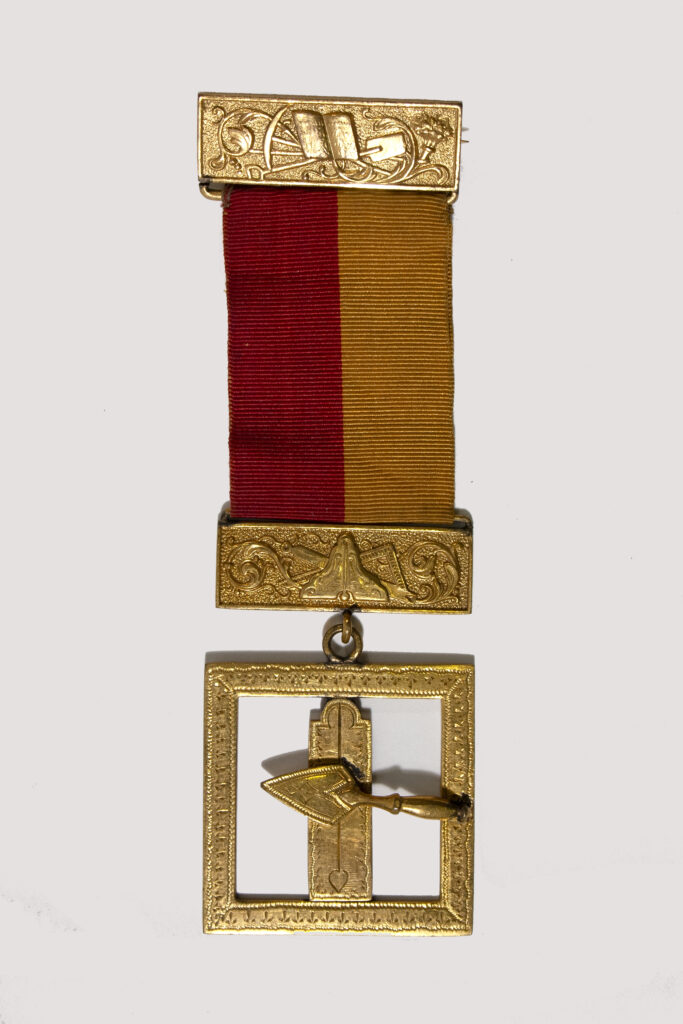
An ivory gavel presented to MW Charles Smith by Hebron Lodge no. 813, at the dedication of Hebron Masonic Temple in November 14th, 1913.
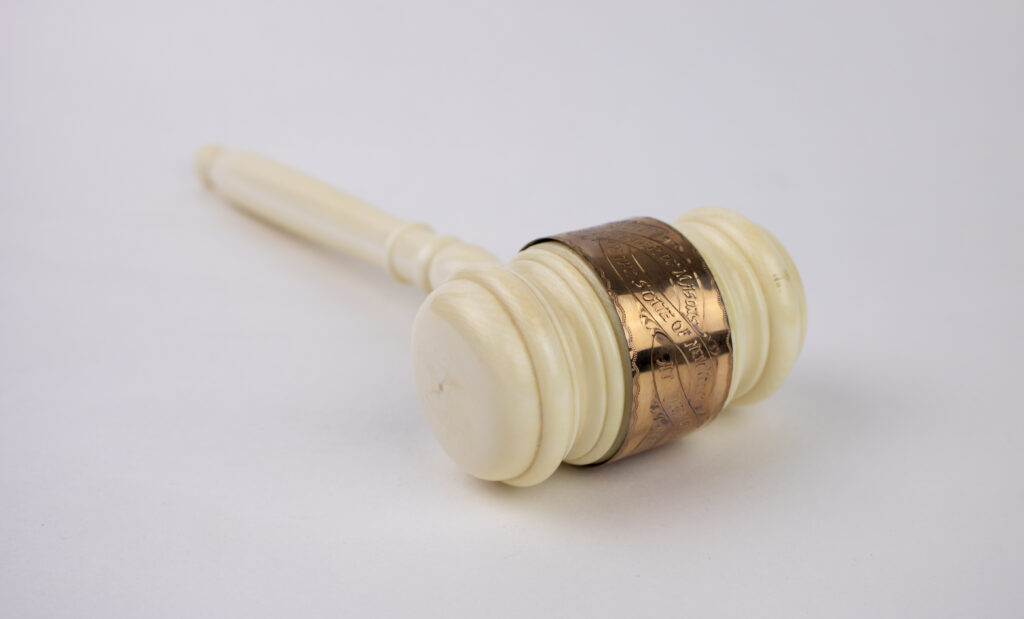
A souvenir gavel made of whalebone from Nome, Alaska, with a handle carved in the figure of a seal. Presented to Adelphi Lodge No. 23 by Abraham Simson in 1905.
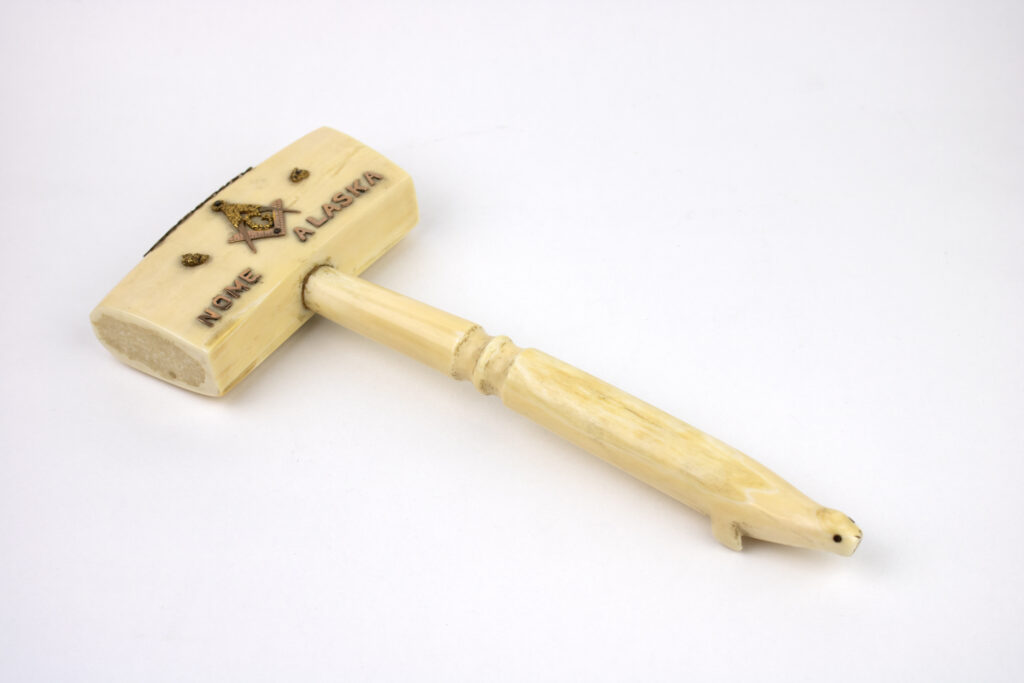
The last and not least is Processus Contra Templarios, parchments of the hearings of the Trial against the Knights Templar in 1308, the faithful reproduction of manuscripts from the Vatican archive. Only 799 copies were published in 2007, and the Grand Lodge of New York has one in possession.
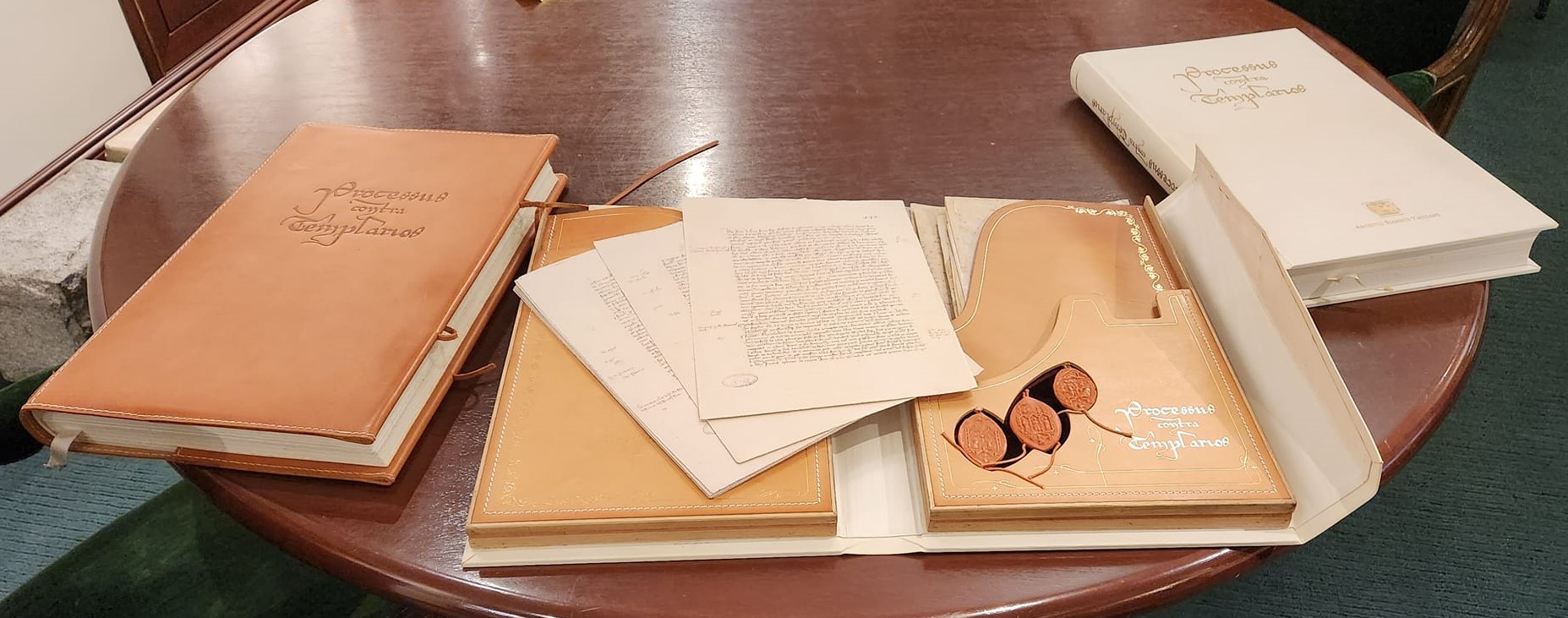
(updated: add more images 2/22/2024)
We are working hard to inventory the Grand Lodge of New York’s massive collection for the first time in decades. As we progress, many antique photographs, also known as cabinet cards, have been rediscovered within the collection, many of which are the portraits of the Past Grand Masters of New York during the late 19th Century, around the same time cabinet card was at the peak of its popularity.
We are pleased to highlight them in this blog as they are the rare original portrait of the Past Grand Masters of New York. More antique and modern Grand Lodge of New York’ photograph collection can be found in our online museum.
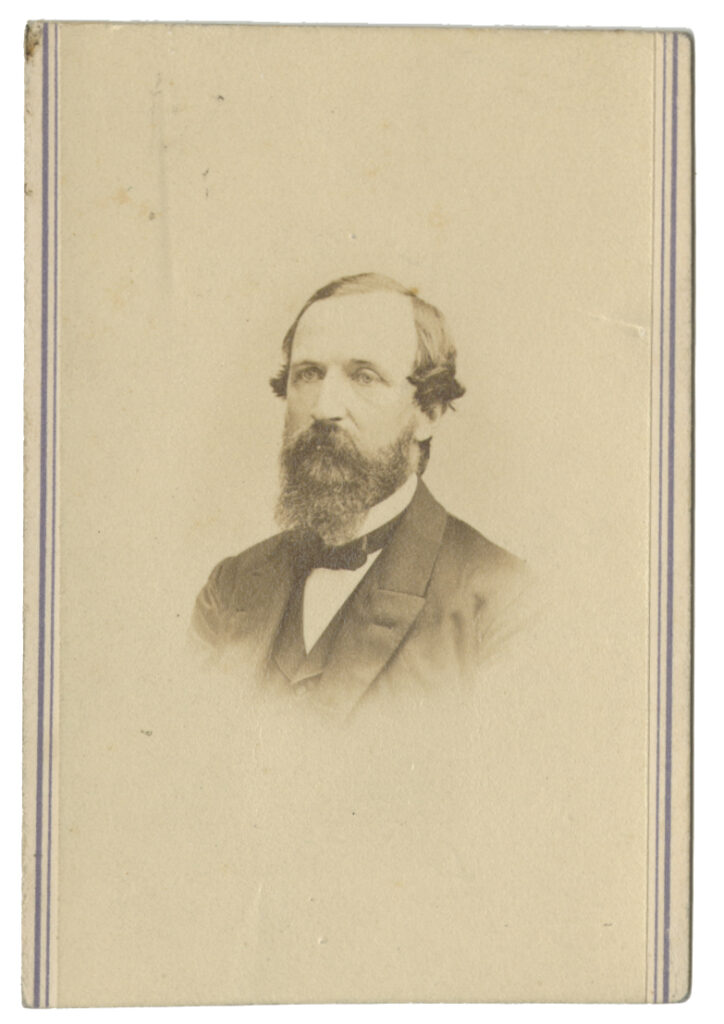
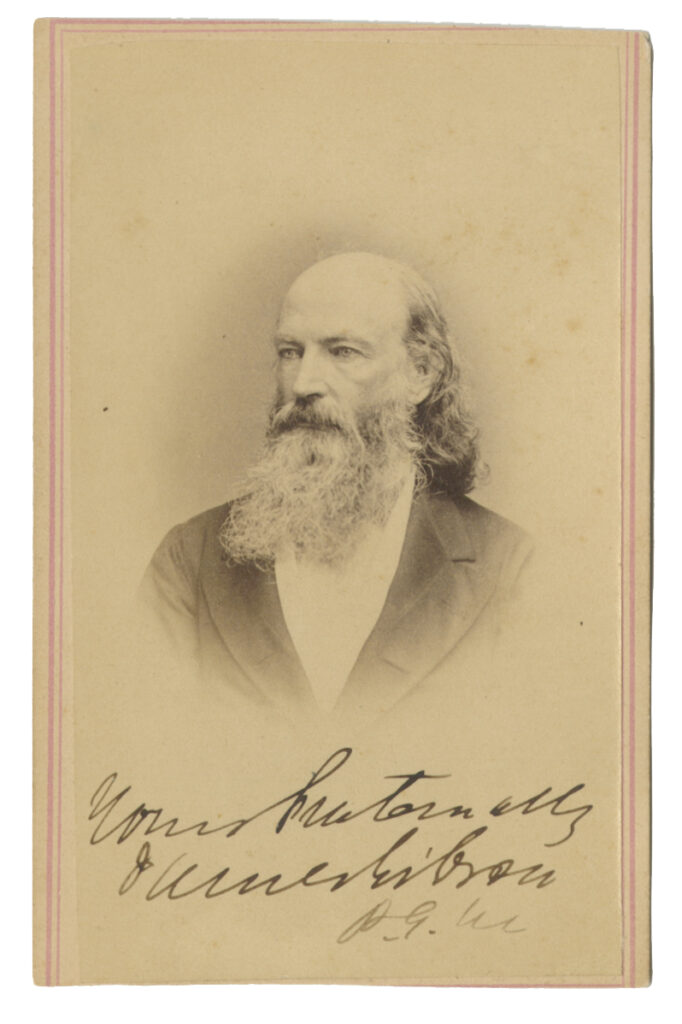
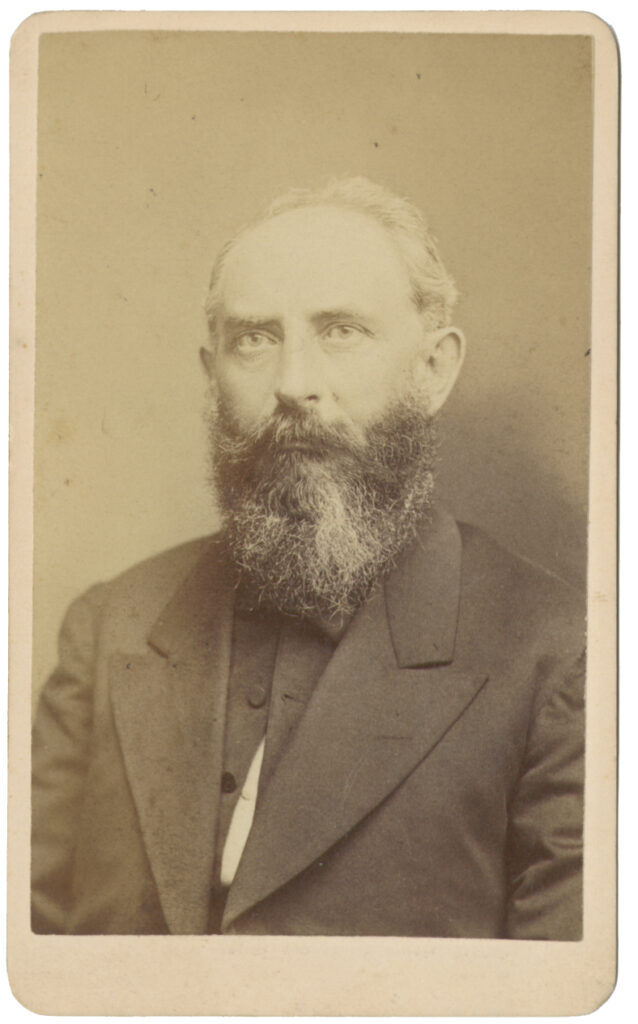
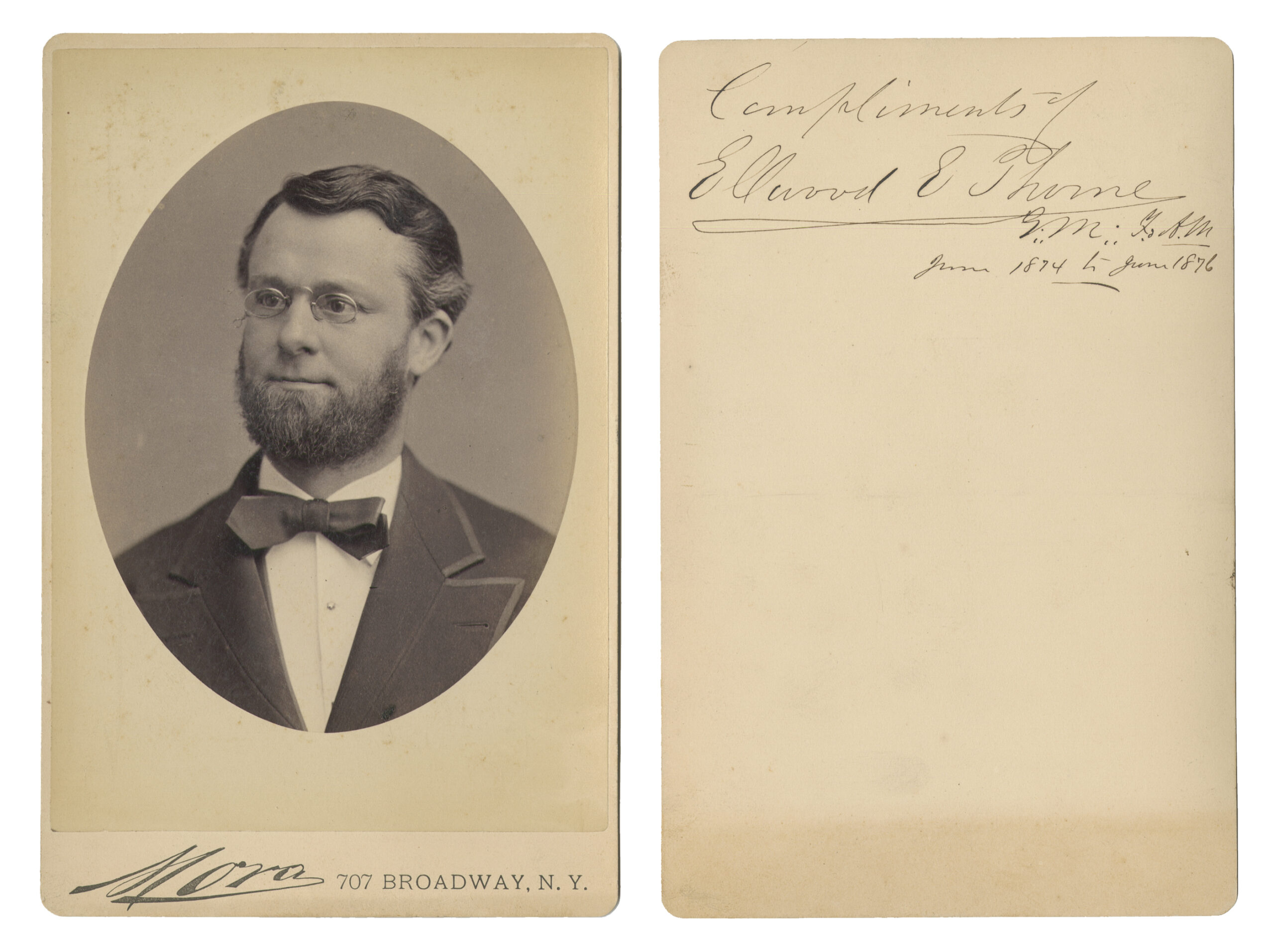
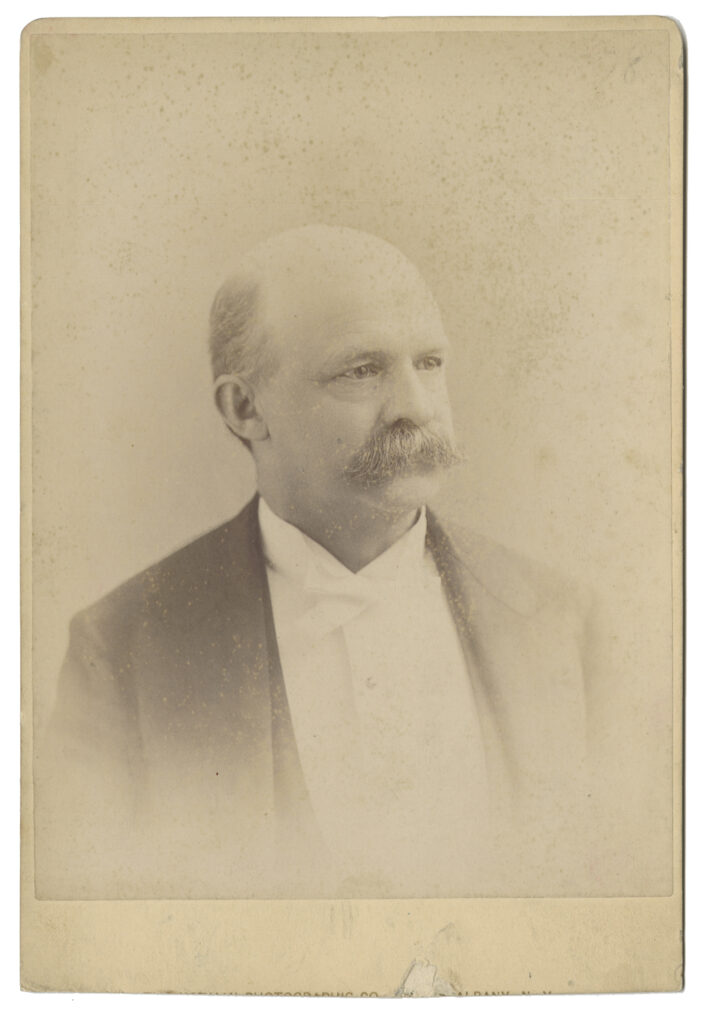
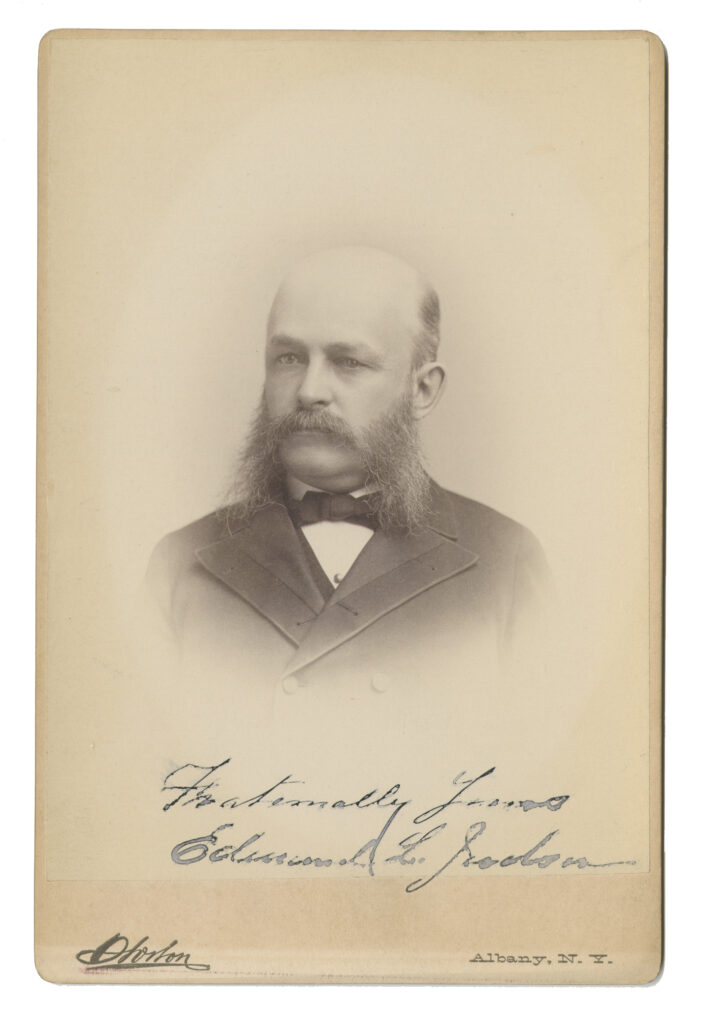
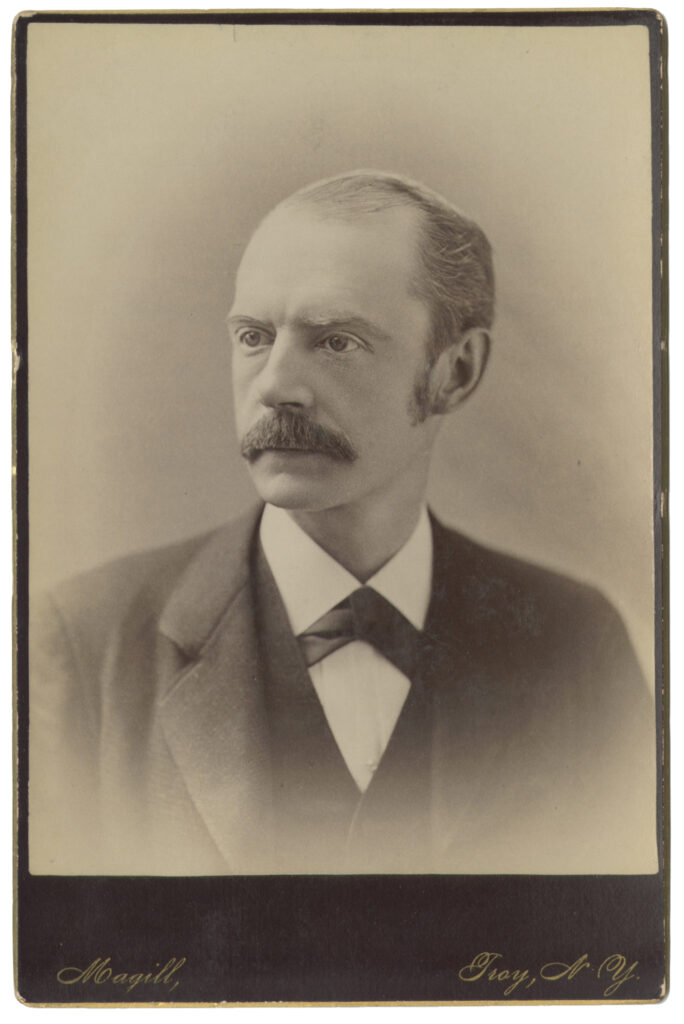
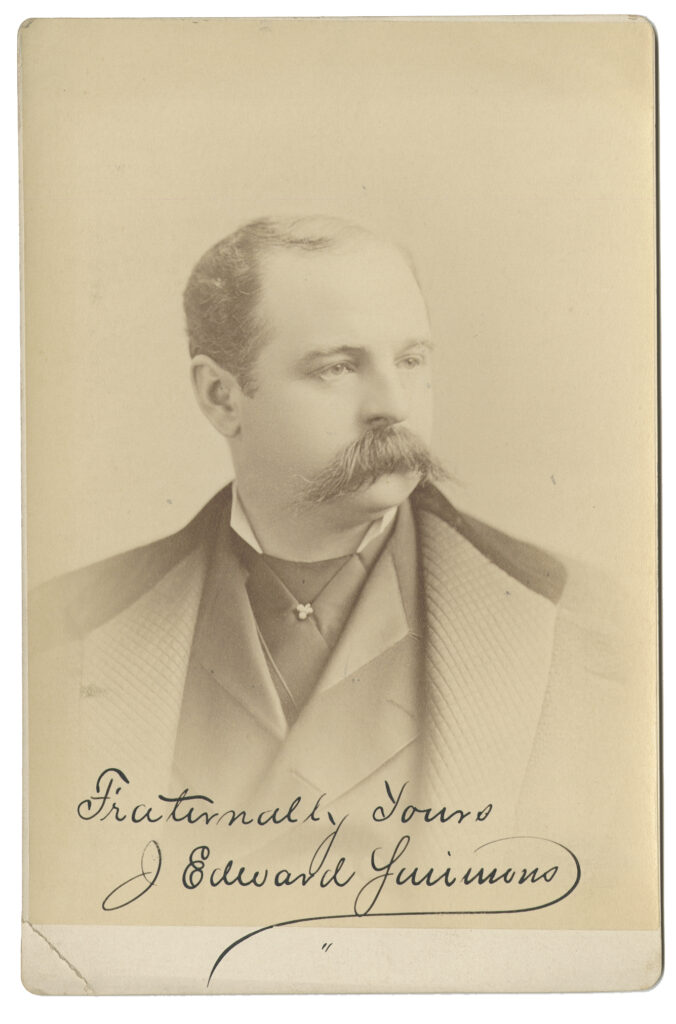
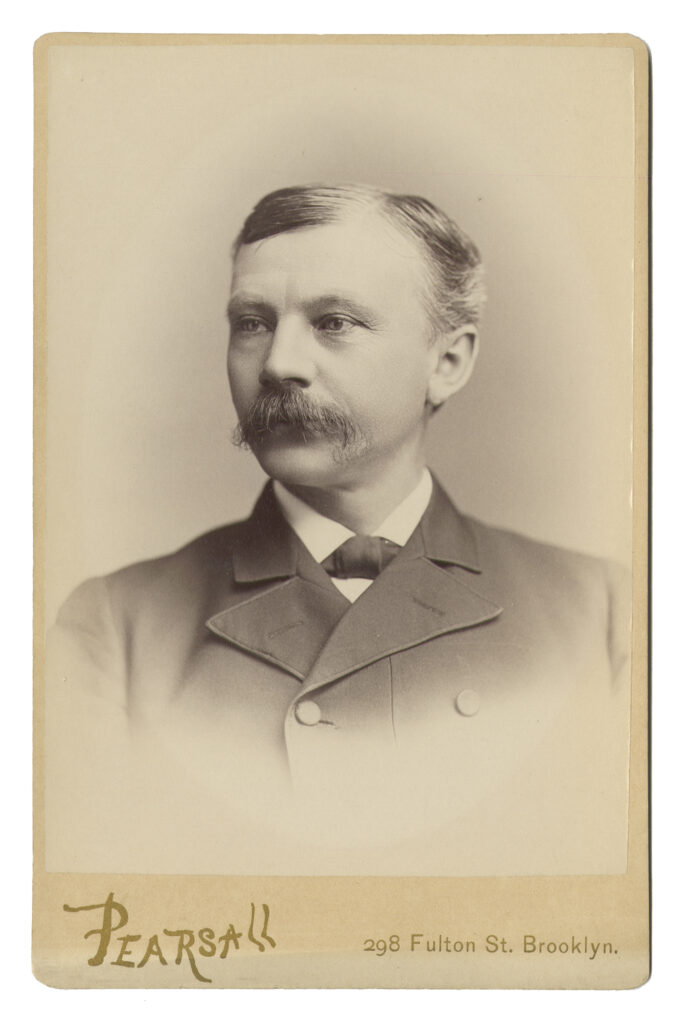
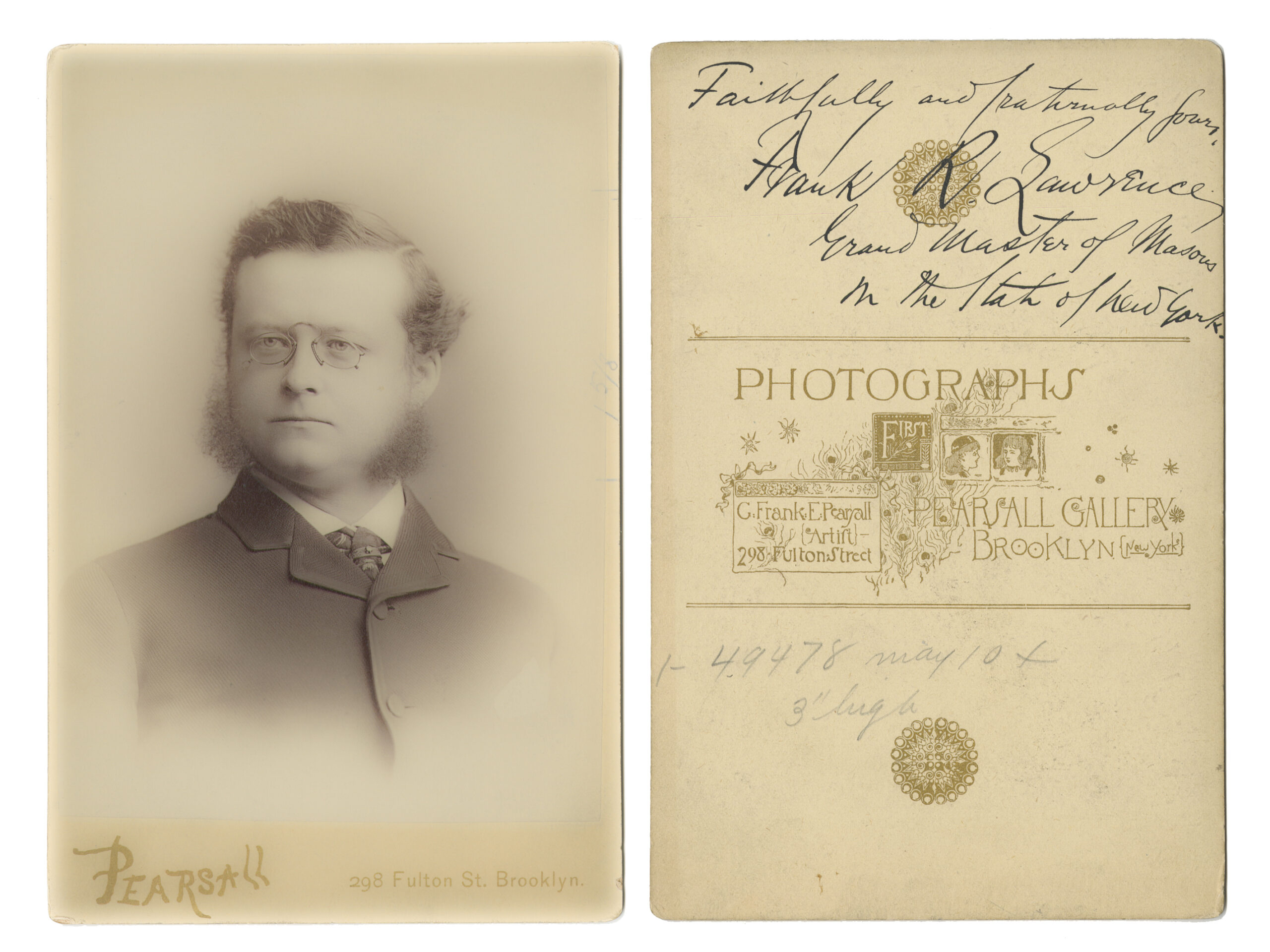
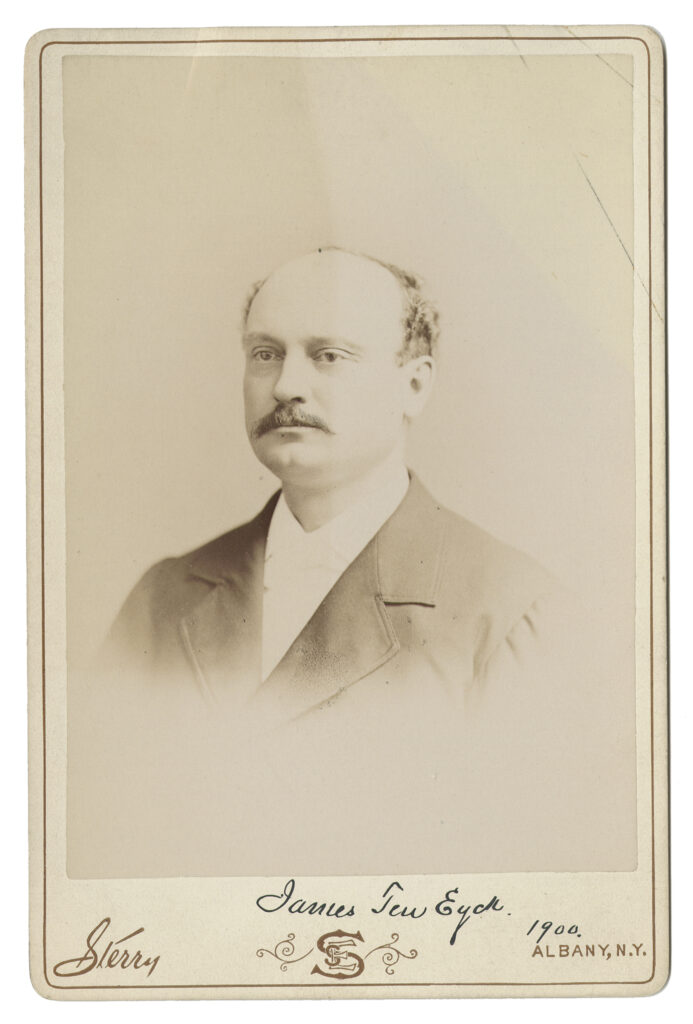
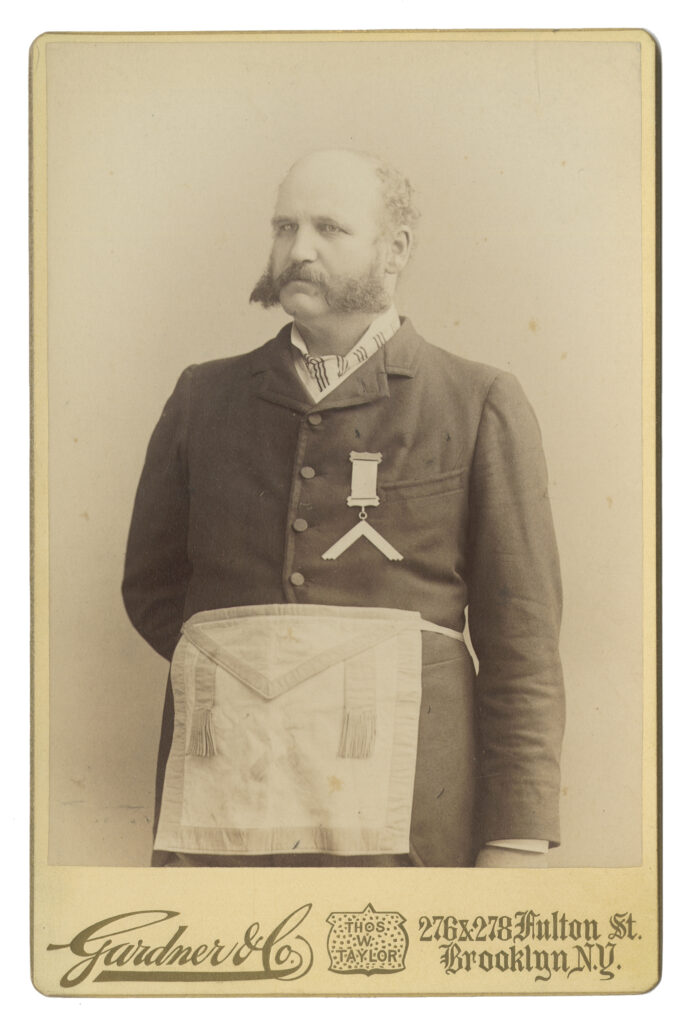


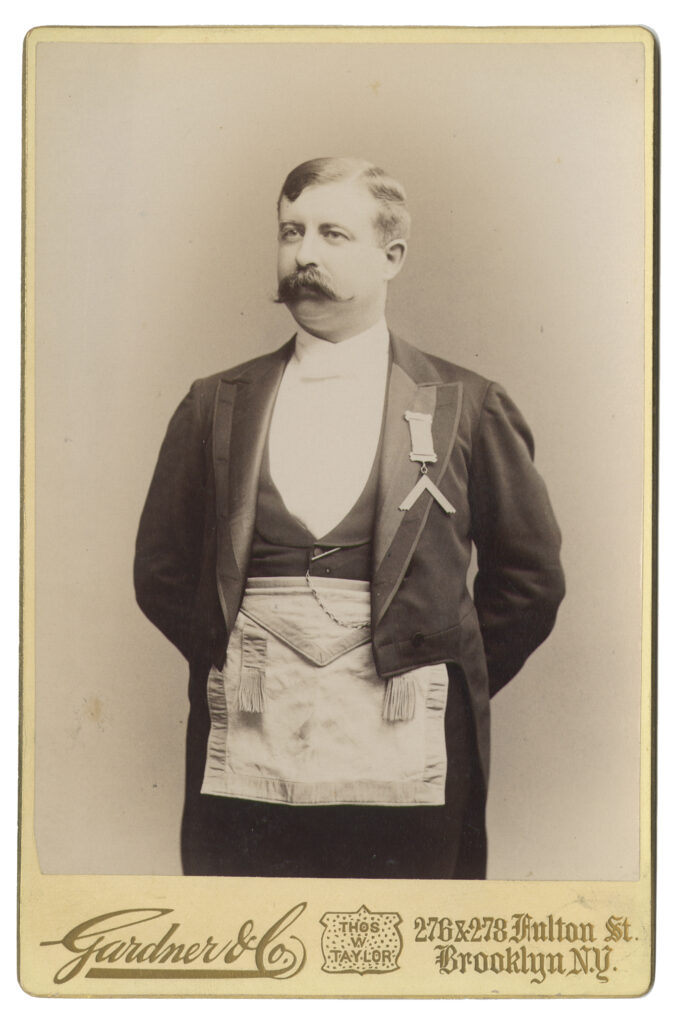
In occasion of the Grand Lecturer Convention held at the Grand Lodge of New York. We are excited to present the special exhibit featuring Masonic artifacts from two historical figures of Latin America: Simón Bolívar and Antonio López de Santa Anna.
The rumor said that General Sam Houston, who was a freemason, spared Santa Anna after the battle of San Jacinto after he recognized his Masonic sign of distress. It sparked the speculation and debate over the legitimacy of Santa Anna‘s Masonic membership, as there was no solid evidence of his Masonic affiliation. Only until the curator of Robert R Livingston Library, Catherine Walter, discovered Santa Anna’s Scottish Rite certificate in the collection, confirming that Santa Anna was indeed a Freemason.
The certificate was donated to The Grand Lodge of New York by Gustavo Ferrer, Past Master of Americus Lodge No. 535 (now Publicity Lodge No. 1000).
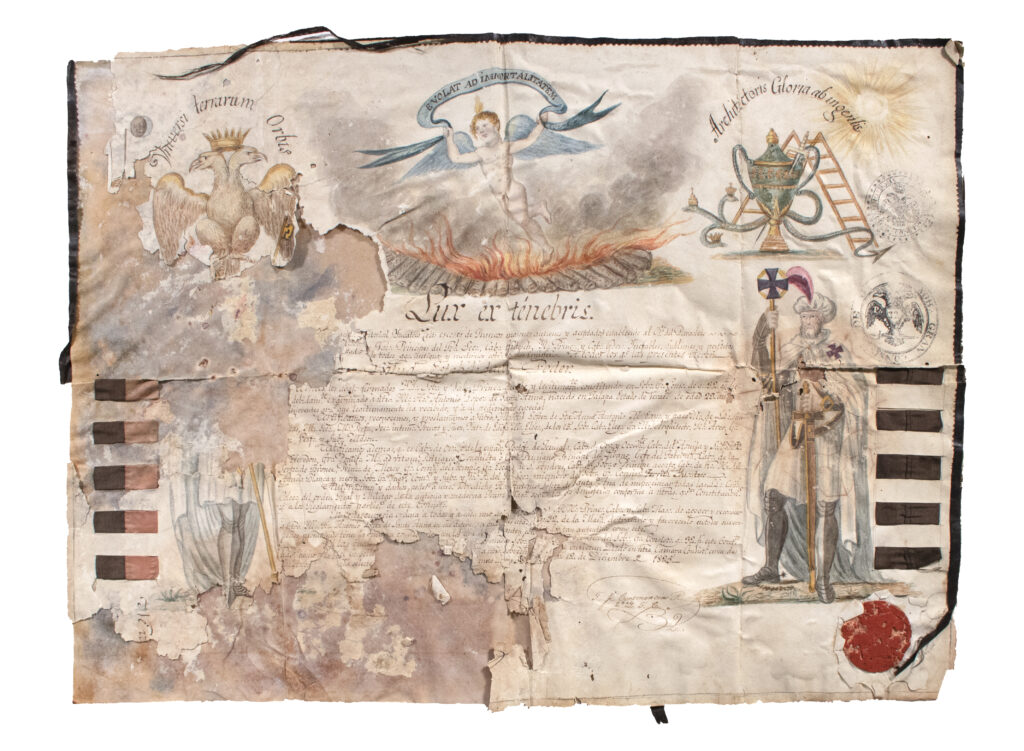
Simón Bolívar was the great liberator who fought to liberate Latin America from Spain. His Scottish Rite apron and collar were donated to the Grand Lodge of New York in 1934 by Francisco Reiguera of La Union Lodge No. 9, Madrid, Spain. Bolívar was initiated in Spain and received his Scottish Rite Degree in France.
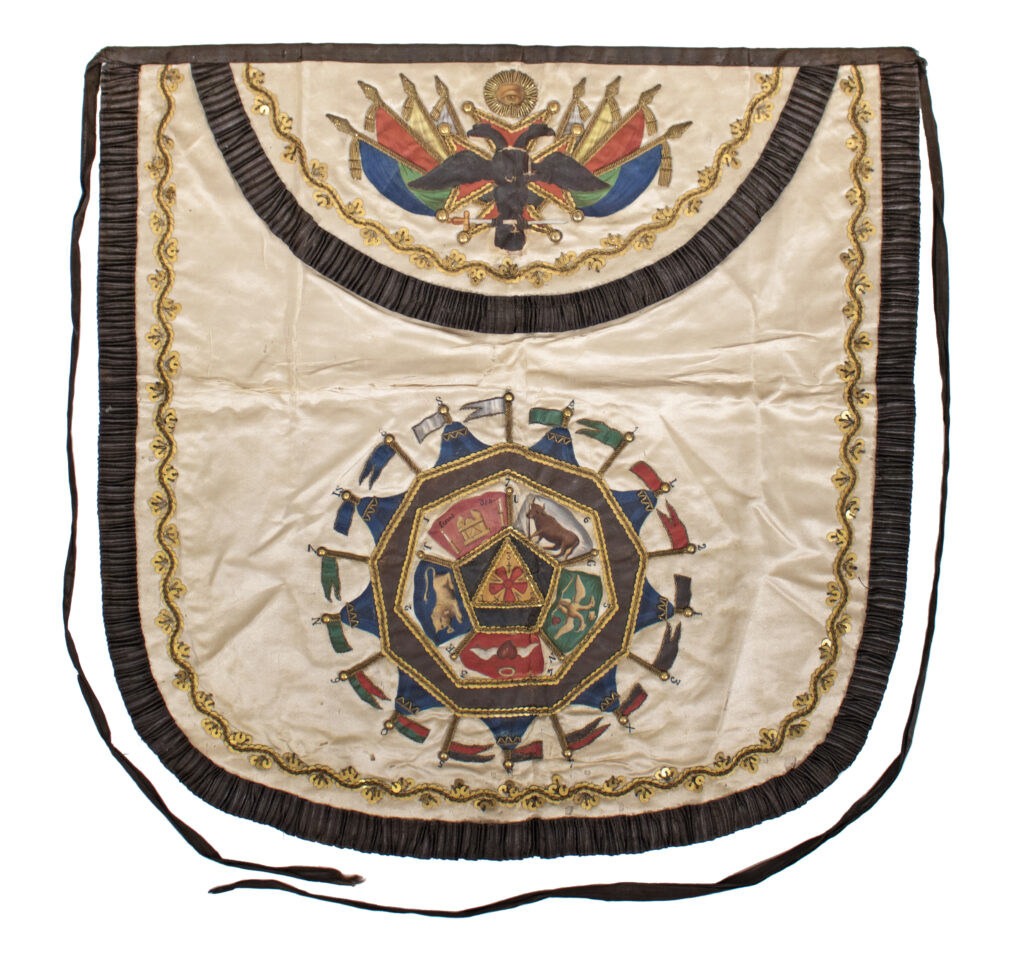
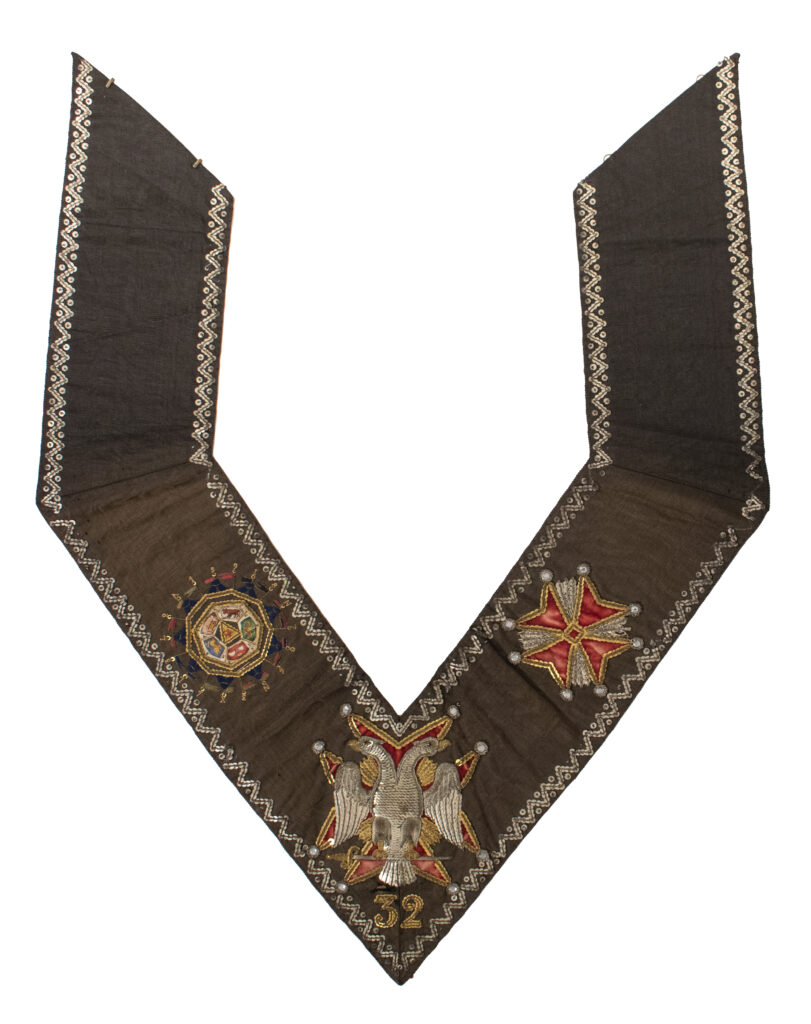
The special exhibit will be on display in Robert R Livingston Library from Monday January 23rd to January 30th 2023. Please note that the certificate on display is a reproduction.
We are delighted to introduce the featured exhibit of the antique Masonic Medals, displaying the selection from our antique Mark Master Medal collection.
The precursor of chapter penny, Mark Master mason would own a Mark Master medal as their personal badge. Mark Master medal is usually a silver piece, with engraving of the owner’s name and his lodge or chapter on the obverse. On the reverse, the ‘Mark’ of the owner would be encircled by the letters: H. T. W. S. S. T. K. S., resembling the keystone symbol of the Royal Arch Masons.
Mark is a tradition derived from operative masons who each had their own mark as the unique signature to identify themselves in their masonry works. After receiving their Mark Degree in Royal Arch Chapter, Mark Master Mason would create their Mark, commonly an imagery or symbol which associate with themselves personally. Their mark would then be recorded in the “Mark Book”. The mark they have chosen would be assigned to them til the end of their Masonic journey.
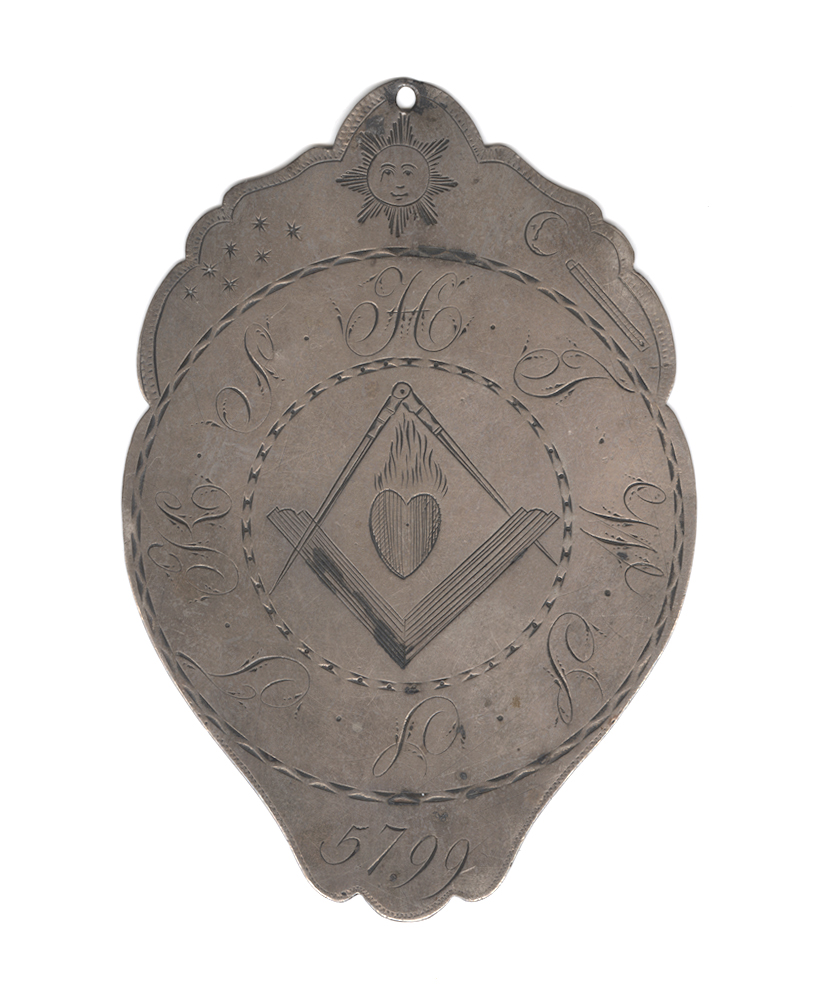
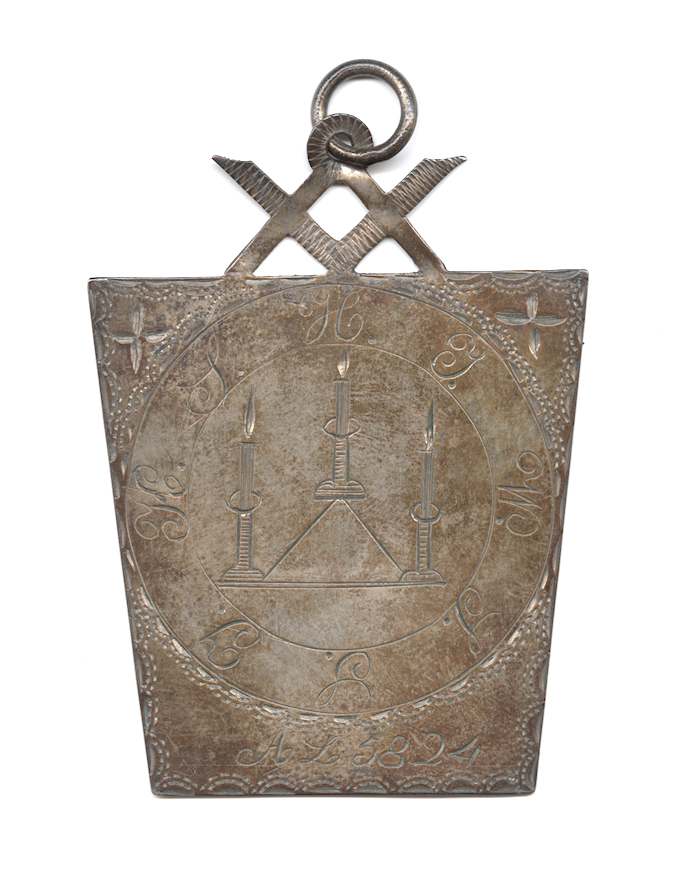
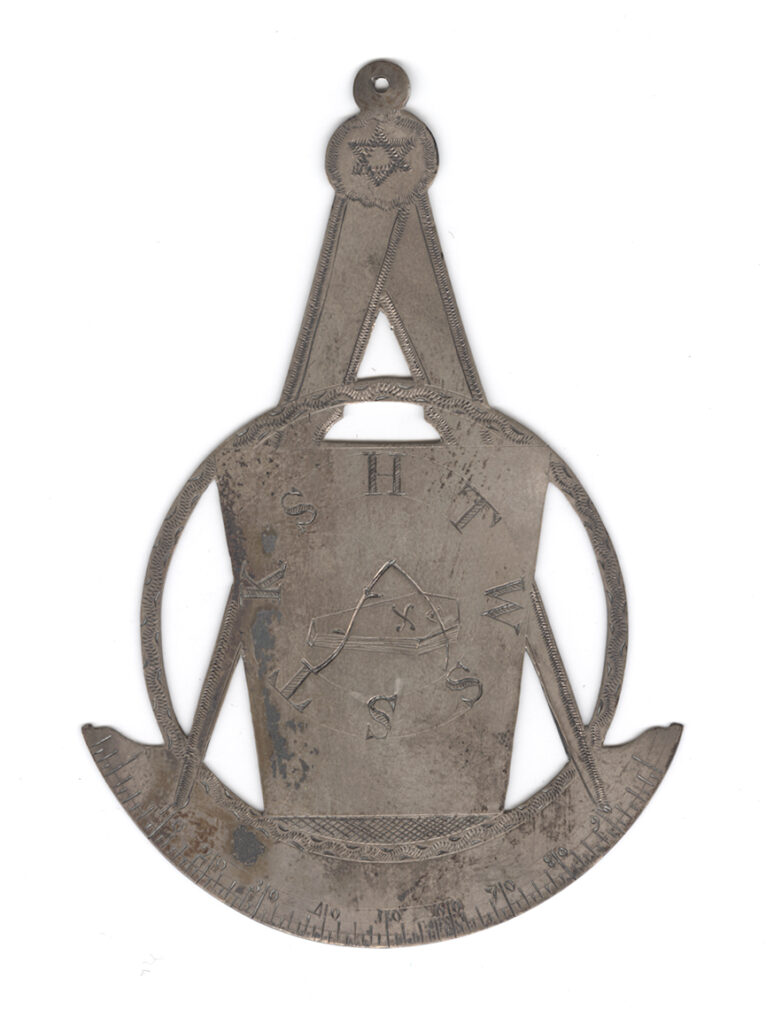
The Mark Master Medal exhibit is on display at the library and is available on the online museum.
Reference:
Hamilton, John D. Material Culture of the American Freemasons. Scottish Rite Masonic Museum and Library, 1994.
Mackey, Albert G. Mackey’s Revised Encyclopedia of Freemasonry, edited by Robert I. Clegg, vol. 2, Macoy Publishing And Masonic Supply Company, New York, New York, 1946, pp. 621–625.
We are pleased to introduce the artifacts of the Masonic Home in Utica that are on the online museum. The collection is currently on display at the Library’s branch site at the Utica Masonic Temple, and now they are also accessible to the public online. One of the highlights of the Utica location displays is the collection of trowels from the cornerstone ceremonies of the remarkable buildings within the Masonic Care Community campus.
50 years after the Masonic Home and Asylum Fund was formed, the history of Masonic Home at Utica began when MW John W. Vrooman laid the cornerstone of the first Masonic Home building in 1891. From then, throughout the years, the campus kept expanding and more buildings and facilities were built to accommodate the residents.
Below is the collection of the historic trowels that were used to lay the cornerstones of the buildings at the Masonic Home.
The Masonic Home Building (Old Administration Building)
The trowel of the Old Administration Building, also known as the Masonic Home, was presented to MW John W. Vrooman by the Trustees of the Masonic Hall and Asylum Fund to lay the cornerstone on May 9th 1891. It is beautifully engraved with a picture of the building, along with the names of the Trustees.
The Masonic Home Building was the very first building erected in Utica to be a care facility for aged Masons and deceased Masons’ widows and orphans.
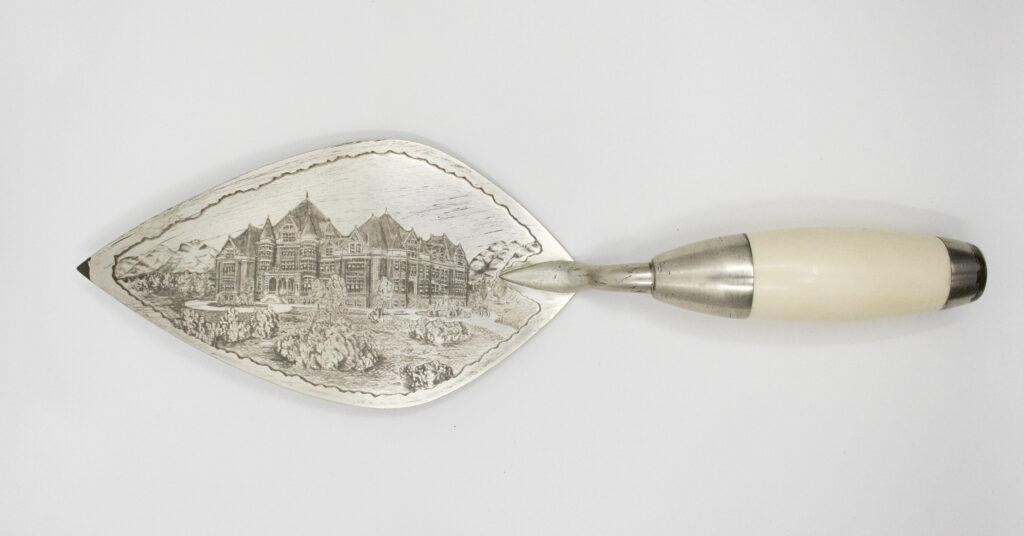
Memorial Building for Children
The trowel of the cornerstone of the Memorial Building for Children was presented to MW John Stewart by the Trustees of Masonic Home and Asylum Fund on June 29th, 1896. The trowel is not only engraved with a picture of the building, but is also decorated with an ornate handle.
The building was built to serve as the care and education facility for the children of the Masonic Home.
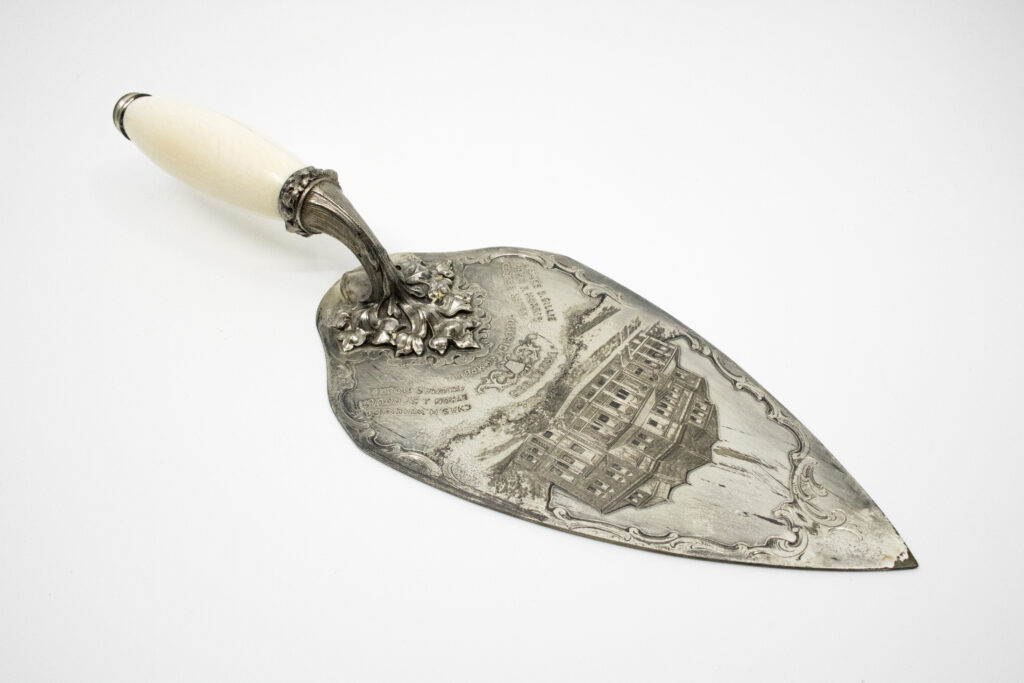
Daniel D. Tompkins Chapel
Named after Daniel D. Tompkins, U.S. Vice President and Governor of New York, the Chapel was built to provide religious services to the residents of the Masonic Home after the Chapel room in the Administration Building had become too small. The cornerstone was laid on April 10th, 1910 by MW Samuel N. Sawyer.
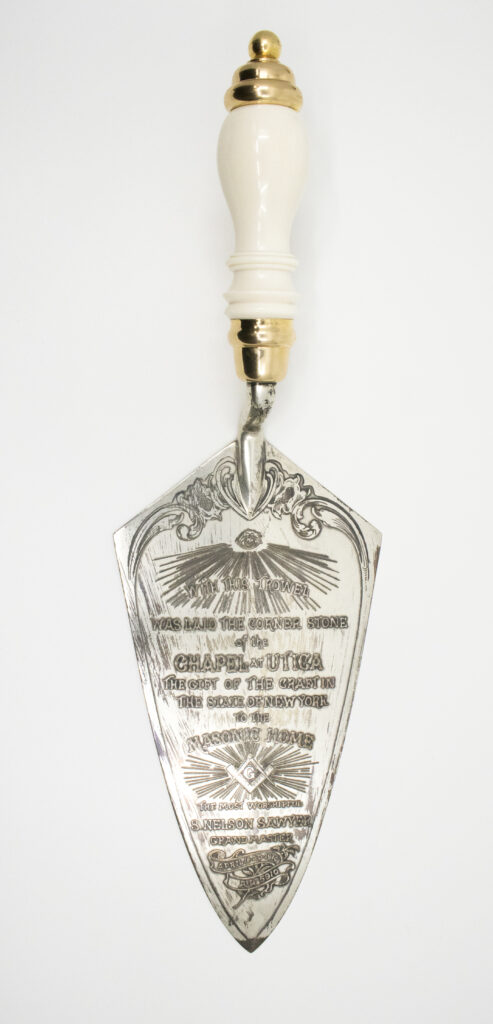
Knights Templar Educational Building
Also known as just the Knights Templar building, it was a gift from the Grand Commandery of New York to the Masonic Hall and Asylum Fund. It was built to be the girl’s dormitory to accommodate the increasing number of residents. The cornerstone was laid by MW John B. Mullan on May 8th, 1915.
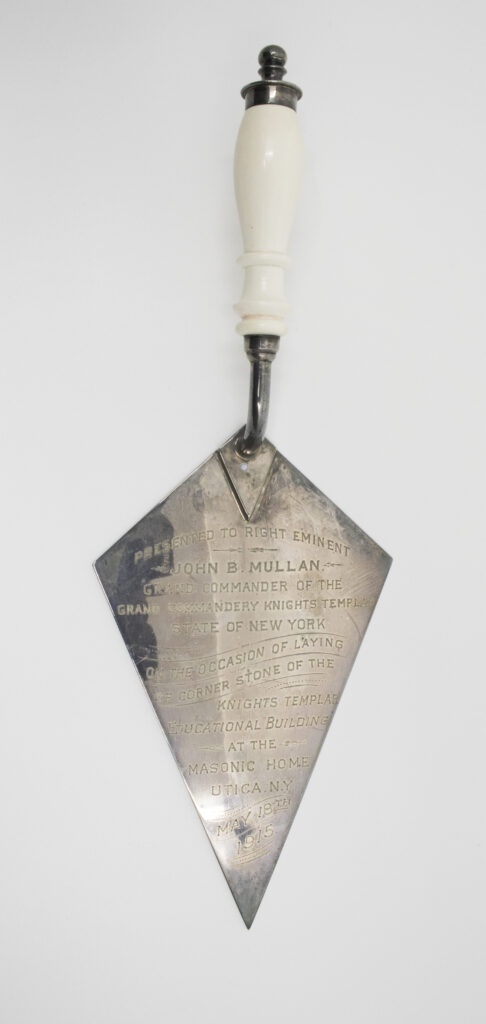
Masonic Soldiers’ and Sailors’ Memorial Hospital
The trowel of Soldiers’ and Sailors’ Memorial Hospital was used by WM William S. Farmer to lay the cornerstone of the hospital on September 20, 1919.
The hospital was proposed to provide free healthcare to soldiers and Masonic members in need. The architect was Harry P. Knowles, the same architect who worked on the Grand Lodge of New York Building. The elaborated story of the Soldiers’ and Sailors’ Memorial Hospital and its cornerstone can be read here.
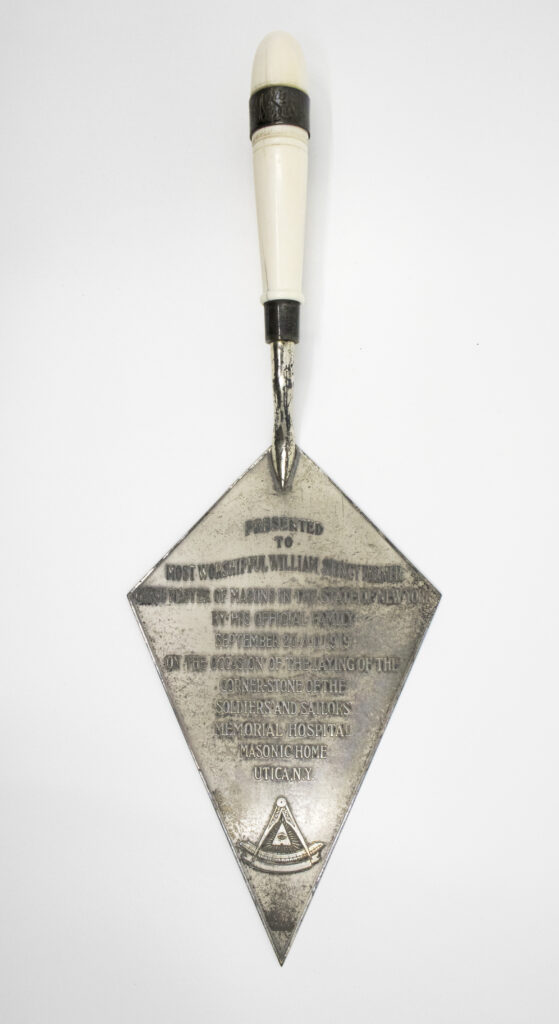
Isaac R. Stewart Memorial Wing
This trowel used to lay the cornerstone of Isaac R. Stewart Wing by MW Harry Ostrov on June 22nd, 1963. The wing is an expansion of the Soldiers’ and Sailors’ Memorial Hospital to accommodate the increasing numbers of the residents. Its cornerstone was recovered in 2021. More of the Isaac R. Stewart Memorial Wing and its cornerstone can be read here.
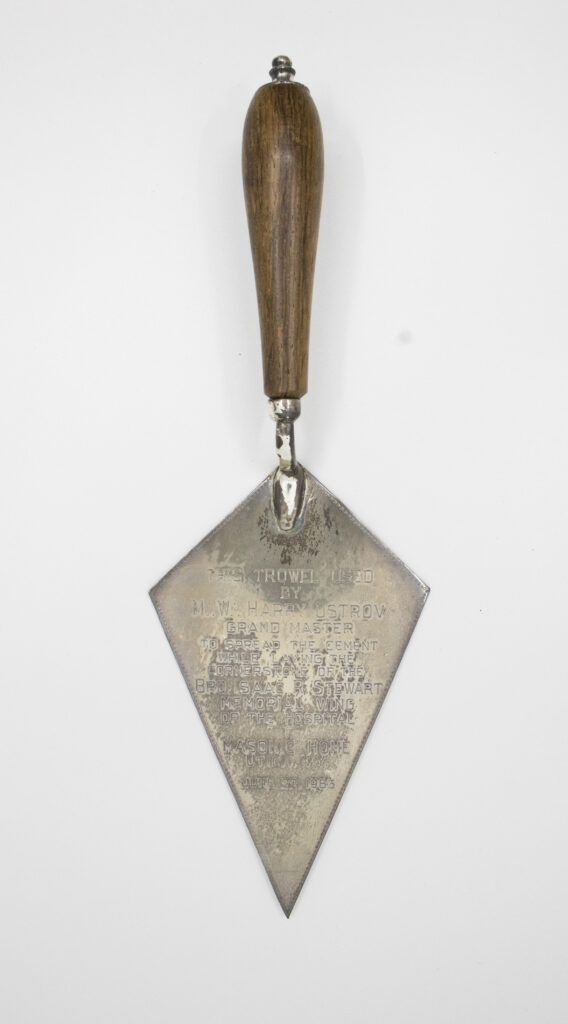
The New Administration Building
75 Years after the first Masonic Home building in Utica campus was dedicated, it was replaced with the New Administration building to meet the functionality needed for the now populated Utica campus. The cornerstone was laid by MW Clarence J. Henry on June 19th, 1965.
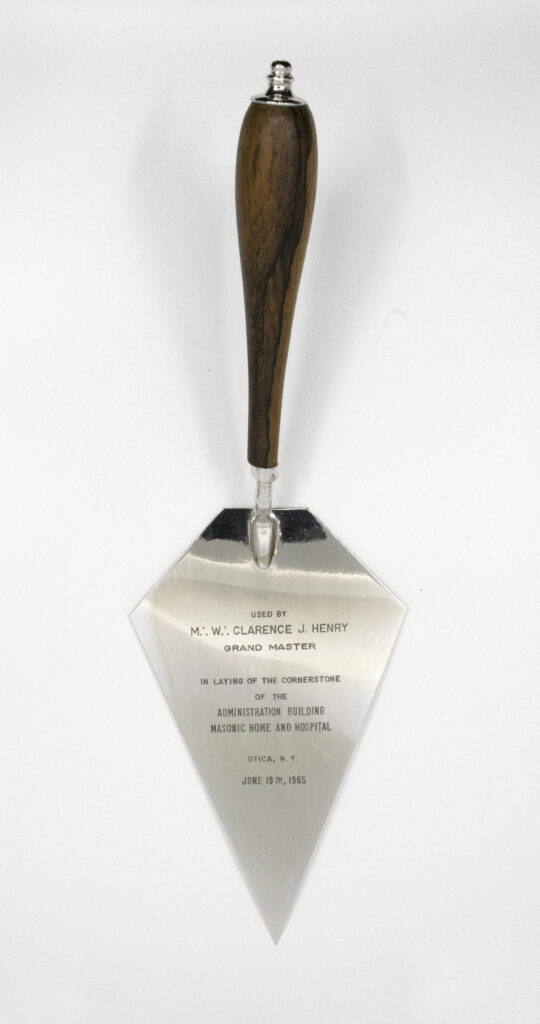
By Alexander Vastola, Director
At the end of April 2022, the rehousing project of the Grand Lodge Collection was complete. In the process of completing the Collection, I drafted a basic finding aid of the Collection. This finding aid will be used for staff reference, but when it is revised, it will be uploaded to the Library’s website for patrons’ reference.
Upon completion of the Grand Lodge Correspondence Collection, many new and interesting letters were discovered. For example, discovered were correspondences relating to the schismatic New York Grand Lodges of the 1840s and 1850s, including rare letters from the St. John’s Grand Lodge and many letters relating to the Phillips Grand Lodge. Furthermore, there were letters in the Collection that documented the Grand Lodge of New York’s establishment of lodges in Columbia, Cuba, Haiti, and Panama. These letters were not in the exhibit for Grand Lodge Week but are filed in the Grand Lodge Correspondence Collection.
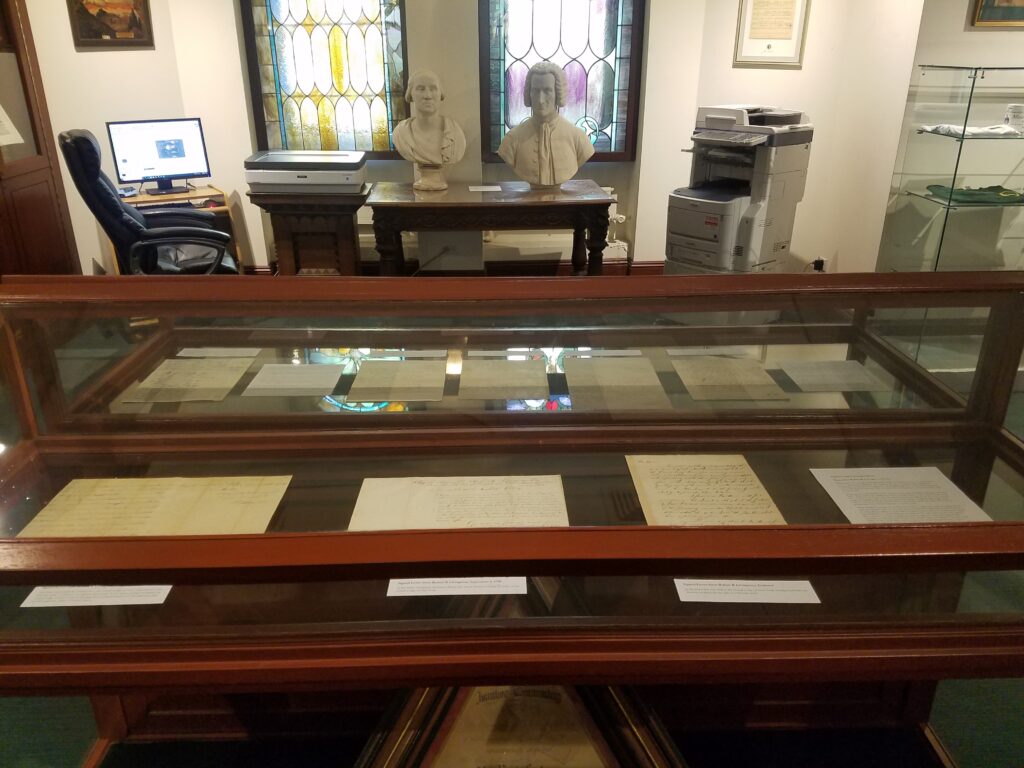
For Grand Lodge Week, an exhibit was created of some of the letters from this Collection that were signed by noteworthy New York Masons who all served as Grand Master of the Grand Lodge of New York. The first three letters in the exhibit were signed by Chancellor Robert R Livingston and document his acceptance of his election as Grand Master in 1784, his appointment of his new Grand Secretary in 1799, and the letter of appreciation to the New York Freemasons for the gift of a Masonic jewel. There were four letters on display signed by New York Governor DeWitt Clinton, documenting his decision to be re-elected as Grand Master and his reception of petitions to form lodges in various parts of New York State. Vice President Daniel D. Tompkins also had a signed letter in this exhibit, which revealed his list of Freemasons who he selected to be his Grand Lodge Officers.
These letters were on display at the Library, throughout the month of May.
In the museum’s store room, there was a massive stash of Royal Arch Mason chapter pennies which had been sitting on the shelf for decades. These chapter pennies were put together in display panels and glued or sealed within a plastic case. As the space in the Museum’s collection cage is growing scarce, the Museum staff agreed to dismantle them to free up storage space and to properly store the pennies.
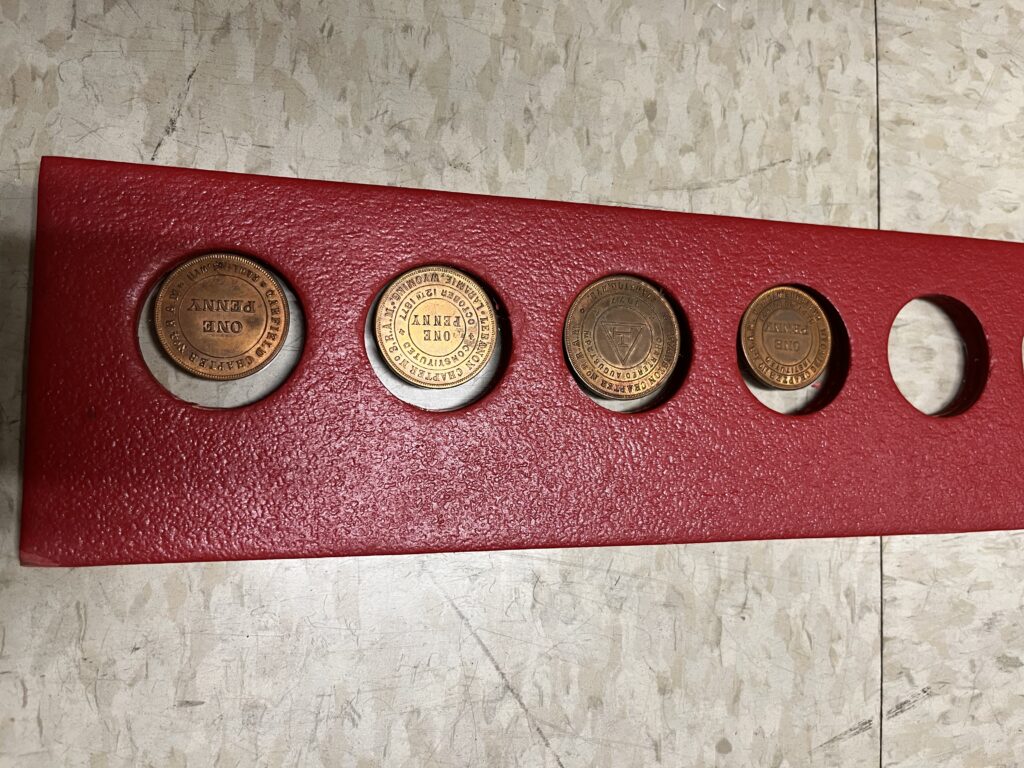
We did not realize how damaged the pennies were until we removed them from the displays. While most had adhesive residues, the ones stored in plastic sleeves were covered in sticky plastic flakes and green residue. We reached out to expert coin conservators, and they helped us confirm that what was happening to the pennies was PVC damage.

It is not uncommon that some practices that were acceptable and considered “modern” in the past are now considered harmful by modern-day curatorial standards. In the numismatic world, PVC is one of the materials that is most damaging to coins, and yet it was commonly used for coin storage decades ago.
PVC, or Polyvinyl chloride, over time, can breakdown and react to metal, leaving permanent damage on the coin’s surface. As the damage takes years to develop before the consequences start to show, it was fairly recent that coin experts and collectors have been aware of PVC’s hazards on coin collections.

The experts instructed us to use acetone solvent to remove PVC from the pennies, which is also effective for removing adhesive. The pennies had been exposed to PVC and adhesive for at least 70 years, causing various degree of damage to the pennies; some were more severe than others.
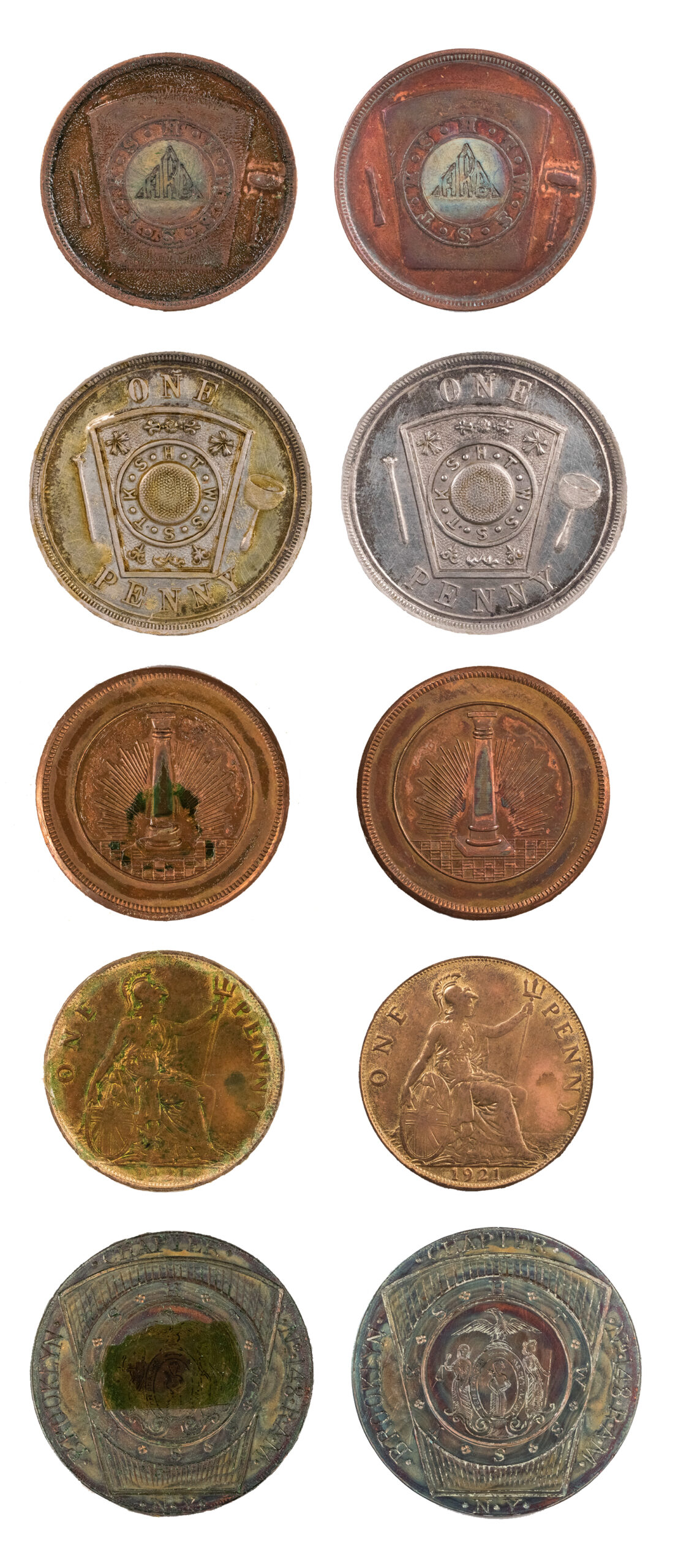

Even with the PVC removed, the damage from it is irreversible. The treatment, at least, removed the PVC residues from the penny’s surface, and thus it would stop or slow down further damage. After the conservation, the chapter pennies are now properly stored in proper archival storage. Even with all the damage done, the New York chapter pennies are still a valuable collection of the Grand Lodge of New York, as the representatives of the Royal Arch Chapters across New York State.
Special Thanks to:
William Eckberg Former President of Early American Coppers (EAC)
Pippa Pearce Senior Conservator of The British Museum
References:
Tchor, Lance. “PVC Damage on World Coins – What It Is & How to Avoid It.” CoinWeek, 25 Oct. 2016.
Reiter, Ed. “Little ‘PVC’ Holders Can Cause Big Problems.” The New York Times, 25 Jan. 1981, p. 35.